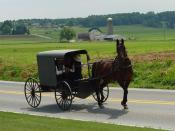" We Americans have the chance to become someday a nation in which all radical stocks and classes can exist in their own selfhoods, but meet on a basis of respect and equality and live together, socially, economically, and politically. We can become a dynamic equilibrium, a harmony of many different elements, in which the whole will be greater than all its parts and greater than any society the world has seen before. It can still happen." -Shirley Anita ChisolmThough the variation that exists in the many religions of the world is fascinating, it is also quite remarkable that people from such different societies and ways of life share something so abstract as a belief in some sort of immaterial being and a set of values that define their cultural identity. These values directly define the group as a whole, and as individuals. In many ways, their religion dictates how they live their daily lives.
Unfortunately, the way they are often perceived in modern American society is through stereotypes. Upon further research and reflection, we will gain a deeper understanding of 2 of these religiously influenced cultures, and discover why they aren't as different as they appear on the surface.
No two cultures in Pennsylvania could seem more contrasting than the Amish and Arab-American Muslim communities. In all appearances they could not be more opposed: The Amish are white, with Scandanavian and German heritage. Arab-American Muslims are people of color coming from many countries including Egypt, Iraq, Jordan, Kuwait, Lebanon, Libya, Mauritania, Morocco, Oman, Palestine, Qatar, Saudi Arabia, Somalia, Sudan, and more. The Amish are typically considered uneducated by American standards, with most children completing school through only the 8th grade. In general, Arab Americans are highly educated. As far as occupation, the Amish almost exclusively work either on privately...


